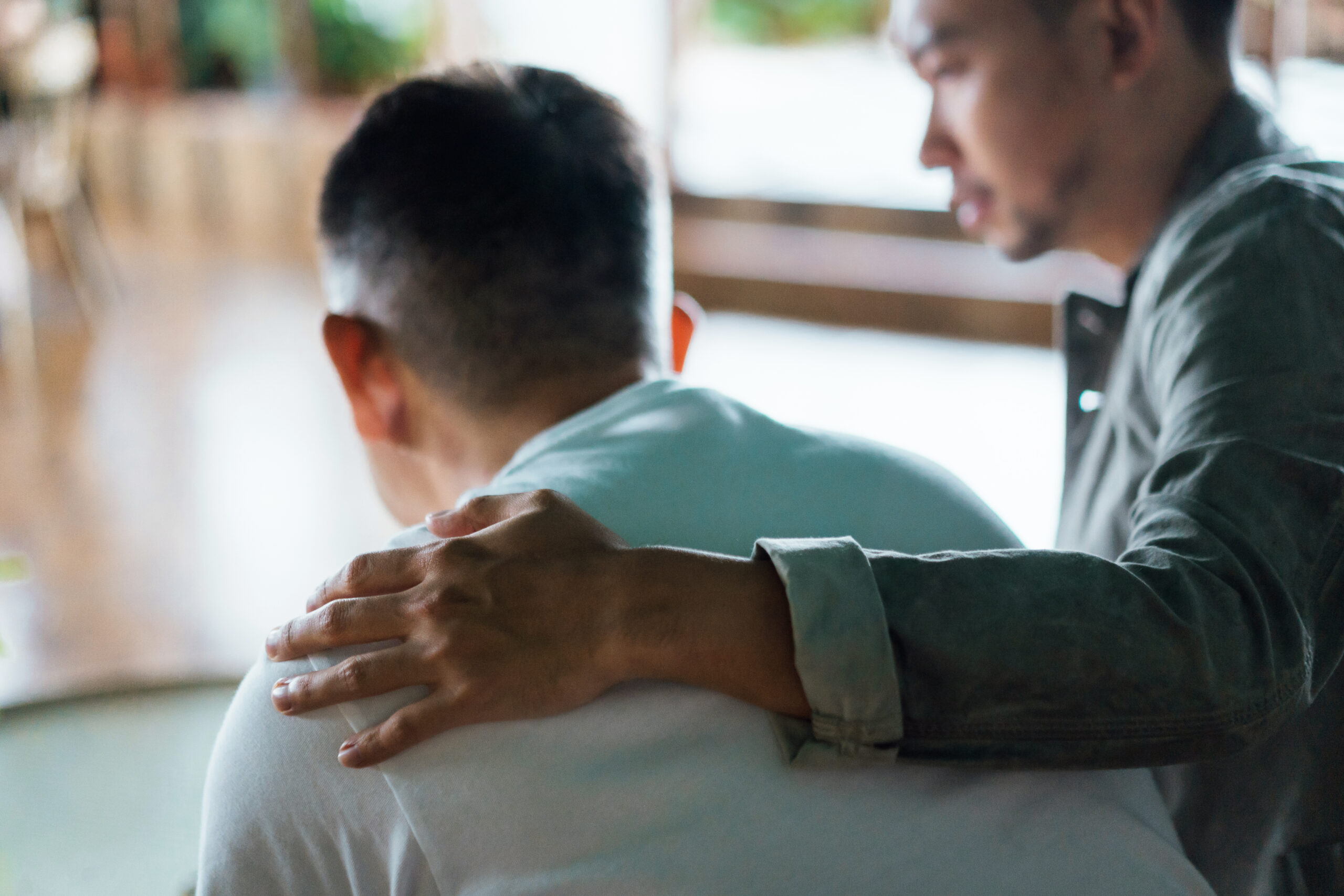If you are concerned about how to keep yourself or a loved one who is thinking about suicide or has attempted suicide safe, this checklist offers a starting point.
Means Safety: Striving to Keep a Loved one Safe from Suicide
Welcome. This website is designed to support you to increase safety for yourself or a loved one, friend, colleague, or client when suicide risk is elevated. Limiting a person’s access to means by which they may cause themselves harm is called lethal means safety, and here you’ll find information about a range of strategies to promote safety in times of crisis or in anticipation of crisis.
Adding time between thoughts of suicide and a person’s ability to obtain lethal means for an attempt represents a practical, lifesaving approach to prevent suicide.
First things first. You are not alone.
If you need immediate help, for yourself or someone else, call or text 988 opens in a new windowopens phone dialer, or chat at 988lifeline.org opens in a new window to reach the Suicide & Crisis Lifeline. You don’t have to be in crisis. Give them a call if you are concerned about yourself, a friend, or family member and not sure what to do.
What is Means Safety?
Means safety for suicide prevention is about limiting a person's access to means, methods, or mechanisms by which they may attempt suicide. Strategies to promote safety in times of crisis or in anticipation of crisis include:
- Place yourself or a person in a safer environment.
- Put a barrier between the person and the means (e.g., bridge barriers).
- Increase the amount of time it takes for yourself or a person to access the means, for example by securely storing firearms, over the counter medications, or prescription drugs – this gives time for intervention or for the crisis to pass.
Means Safety Checklist
If you are concerned about how to keep yourself or a loved one who is thinking about suicide or has attempted suicide safe, this checklist offers a starting point.
- Learn the warning signs of suicide
- Have a conversation about suicide prevention
- Share crisis resources
- Keep medications securely stored at all times
- Dispose of unused, unwanted, or expired medications
- Review the steps to respond to a suspected drug overdose
- Keep guns securely stored
- Familiarize yourself with California laws and options for storing a firearm outside the home
- Trust your instincts
- Remember you are not alone
Learn the Warning Signs for Suicide
Learn the
Warning
Signs for
Suicide
If you are concerned about yourself or someone else and observe one or more of the following warning signs, trust your instincts, and reach out. This is especially urgent if the behavior is new, has increased, or seems related to a painful event, loss, or change.
- Talking about suicide or wanting to die
- Having thoughts of suicide that are intense, pervasive, or difficult to control
- Looking for a way to kill themselves
- Feeling hopeless, desperate, trapped
- Experiencing overwhelming emotional pain
- Giving away possessions
- Reckless behavior
- Uncontrolled anger
- Increased drug or alcohol use
- Withdrawing
- Anxiety, panic, or agitation
- Changes in sleep
- No sense of purpose or reason to live
For more information visit the Suicide Prevention page.
Have Conversations About Suicide
If you’re worried that someone may be having thoughts of suicide, talk to them about your concerns and ask directly: “Are you thinking about suicide or feeling that life may not be worth living?”
Communicating openly about suicide and asking about suicide has been shown to be lifesaving. It encourages people to seek help, promotes a sense of belonging and connects people to care.
For more information visit the Suicide Prevention page.
Provide Information About Crisis Resources
The actual period of heightened risk when someone is capable of suicidal behavior is often only minutes or hours long and accessing crisis resources can help you or someone you care about find hope and a reason for living.
- Share crisis resources: Keep a copy on the fridge, in a wallet, preprogrammed on a phone, in the car, and in other easy to access places.
For more information visit the Find Help Now page.
Poisoning and Responding to Drug Overdose
- Keep all medications securely stored at all times.
- Be vigilant about keeping track of your inventory of pills and refills.
- Dispose of unused, unwanted, or expired medications.
- Review the steps to respond to a suspected drug overdose.
For more information visit the Overdose and Poisoning page.
Preventing Firearm Suicide
Preventing Firearm Suicide
Putting time and distance between a person and firearms during times of suicide distress and crisis can save a life. Keep a loved one safe by applying firearm safety strategies and familiarizing yourself with the law.
- Keep guns securely stored at all times.
- Have a conversation about suicide prevention.
- Consider additional safety precautions such as storing a firearm off-site or outside the home.
There are important things to consider before transferring or storing firearms outside of the home: Know the Law.
Know the Law in California:
Family members and friends are allowed by law to store firearms for someone during times of suicide distress, as long as they meet all of the safety qualifications including, but not limited to: having a firearm permit, being able to safely store the firearm, and they are not prohibited from owning a firearm.
For more information on the California Penal Code Section 27545 and to see all of the requirements for storing firearms for family and friends, visit the Firearm Safety Page.

Trust Your Instincts
If you sense something is wrong, don’t hesitate to act. Have a conversation about your concerns and connect yourself or a loved one with crisis resources and support if needed.
Visit the Find Help Now page for resources.
Last But Not Least!

Last But Not Least!
You are not alone. Whether you are concerned for yourself, a child, a spouse, or someone else, help is available.
Familiarize yourself with crisis lines and community resources available to you. For immediate help call or text 988, or chat 988lifeline.org to reach the Suicide & Crisis Lifeline.
If you have lost someone to suicide, we are very sorry about your loss. Please have a look at resources for survivors for suicide loss to find support.
Means Safety Checklist: Striving to Keep a Loved One Safe From Suicide
If you are concerned about how to keep yourself or a loved one who is thinking about suicide or has attempted suicide safe, this checklist offers a starting point.
First things first. You are not alone.
If you need immediate help, for yourself or someone else, call or text 988 opens in a new windowopens phone dialer, or chat at 988lifeline.org opens in a new window to reach the Suicide & Crisis Lifeline. You don’t have to be in crisis. Give them a call if you are concerned about yourself, a friend, or family member and not sure what to do.
What is Means Safety?
Means safety for suicide prevention is about limiting a person's access to means, methods, or mechanisms by which they may attempt suicide. Strategies to promote safety in times of crisis or in anticipation of crisis include:
- Place yourself or a person in a safer environment.
- Put a barrier between the person and the means (e.g., bridge barriers).
- Increase the amount of time it takes for yourself or a person to access the means, for example by securely storing firearms, over the counter medications, or prescription drugs – this gives time for intervention or for the crisis to pass.
Means Safety Checklist
If you are concerned about how to keep yourself or a loved one who is thinking about suicide or has attempted suicide safe, this checklist offers a starting point.
- Learn the warning signs of suicide
- Have a conversation about suicide prevention
- Share crisis resources
- Keep medications securely stored at all times
- Dispose of unused, unwanted, or expired medications
- Review the steps to respond to a suspected drug overdose
- Keep guns securely stored
- Familiarize yourself with California laws and options for storing a firearm outside the home
- Trust your instincts
- Remember you are not alone
Learn the Warning Signs for Suicide
Learn the
Warning
Signs for
Suicide
If you are concerned about yourself or someone else and observe one or more of the following warning signs, trust your instincts, and reach out. This is especially urgent if the behavior is new, has increased, or seems related to a painful event, loss, or change.
- Talking about suicide or wanting to die
- Having thoughts of suicide that are intense, pervasive, or difficult to control
- Looking for a way to kill themselves
- Feeling hopeless, desperate, trapped
- Experiencing overwhelming emotional pain
- Giving away possessions
- Reckless behavior
- Uncontrolled anger
- Increased drug or alcohol use
- Withdrawing
- Anxiety, panic, or agitation
- Changes in sleep
- No sense of purpose or reason to live
For more information visit the Suicide Prevention page.
Have Conversations About Suicide
If you’re worried that someone may be having thoughts of suicide, talk to them about your concerns and ask directly: “Are you thinking about suicide or feeling that life may not be worth living?”
Communicating openly about suicide and asking about suicide has been shown to be lifesaving. It encourages people to seek help, promotes a sense of belonging and connects people to care.
For more information visit the Suicide Prevention page.
Provide Information About Crisis Resources
The actual period of heightened risk when someone is capable of suicidal behavior is often only minutes or hours long and accessing crisis resources can help you or someone you care about find hope and a reason for living.
- Share crisis resources: Keep a copy on the fridge, in a wallet, preprogrammed on a phone, in the car, and in other easy to access places.
For more information visit the Find Help Now page.
Poisoning and Responding to Drug Overdose
- Keep all medications securely stored at all times.
- Be vigilant about keeping track of your inventory of pills and refills.
- Dispose of unused, unwanted, or expired medications.
- Review the steps to respond to a suspected drug overdose.
For more information visit the Overdose and Poisoning page.
Preventing Firearm Suicide
Preventing Firearm Suicide
Putting time and distance between a person and firearms during times of suicide distress and crisis can save a life. Keep a loved one safe by applying firearm safety strategies and familiarizing yourself with the law.
- Keep guns securely stored at all times.
- Have a conversation about suicide prevention.
- Consider additional safety precautions such as storing a firearm off-site or outside the home.
There are important things to consider before transferring or storing firearms outside of the home: Know the Law.
Know the Law in California:
Family members and friends are allowed by law to store firearms for someone during times of suicide distress, as long as they meet all of the safety qualifications including, but not limited to: having a firearm permit, being able to safely store the firearm, and they are not prohibited from owning a firearm.
For more information on the California Penal Code Section 27545 and to see all of the requirements for storing firearms for family and friends, visit the Firearm Safety Page.

Trust Your Instincts
If you sense something is wrong, don’t hesitate to act. Have a conversation about your concerns and connect yourself or a loved one with crisis resources and support if needed.
Visit the Find Help Now page for resources.
Last But Not Least!

Last But Not Least!
You are not alone. Whether you are concerned for yourself, a child, a spouse, or someone else, help is available.
Familiarize yourself with crisis lines and community resources available to you. For immediate help call or text 988, or chat 988lifeline.org to reach the Suicide & Crisis Lifeline.
If you have lost someone to suicide, we are very sorry about your loss. Please have a look at resources for survivors for suicide loss to find support.

Preventing Firearm Suicide
Firearm safety strategies that can be applied in the home or at firearm ranges or retail stores.
Overdose and Poisoning
Tips to reduce access to medications and other potential poisons in your home, immediate steps you can take to respond to an overdose, and how to implement suicide prevention strategies in pharmacy settings.
Strangulation and Suffocation
Strategies that can be applied in the home, jails, hospitals, and other controlled environments.
Signage, Barriers, and More
Environmental strategies for community planners that place barriers and signage to create time and space for the individual in pain to reach out for help.







